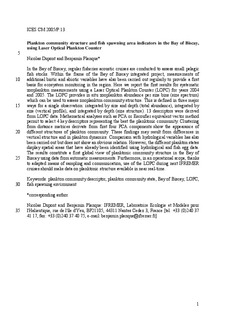| dc.contributor.author | Dupont, Nicolas | |
| dc.contributor.author | Planque, Benjamin | |
| dc.date.accessioned | 2012-03-21T12:23:13Z | |
| dc.date.available | 2012-03-21T12:23:13Z | |
| dc.date.issued | 2005 | |
| dc.identifier.citation | This report is not to be quoted without prior consultation with the General Secretary. | no_NO |
| dc.identifier.uri | http://hdl.handle.net/11250/102195 | |
| dc.description.abstract | In the Bay of Biscay, regular fisheries acoustic cruises are conducted to assess small pelagic fish stocks. Within the frame of the Bay of Biscay integrated project, measurements of additional biotic and abiotic variables have also been carried out regularly to provide a first basis for ecosystem monitoring in the region. Here we report the first results for systematic zooplankton measurements using a Laser Optical Plankton Counter (LOPC) for years 2004 and 2005. The LOPC provides in situ zooplankton abundance per size bins (size spectrum) which can be used to assess zooplankton community structure. This is defined in three major ways for a single observation: integrated by size and depth (total abundance), integrated by size (vertical profile), and integrated by depth (size structure). 13 descriptors were derived from LOPC data. Mathematical analyses such as PCA or Escoufier equivalent vector method permit to select 4 key descriptors representing the best the planktonic community. Clustering from distance matrices derivate from first four PCA components show the appearance of different structures of plankton community. These findings may result from differences in vertical structure and in plankton dynamics. Comparison with hydrological variables has also been carried out but does not show an obvious relation. However, the different plankton states display spatial areas that have already been identified using hydrological and fish egg data. The results constitute a first global view of planktonic community structure in the Bay of Biscay using data from automatic measurements. Furthermore, in an operational scope, thanks to adapted means of sampling and communication, use of the LOPC during next IFREMER cruises should make data on planktonic structure available in near real-time. | no_NO |
| dc.language.iso | eng | no_NO |
| dc.publisher | ICES | no_NO |
| dc.relation.ispartofseries | ICES CM Documents;2005/P:13 | |
| dc.subject | plankton | no_NO |
| dc.subject | spawning areas | no_NO |
| dc.subject | gyteplasser | no_NO |
| dc.title | Plankton community structure and fish spawning area indicators in the Bay of Biscay, using Laser Optical Plankton Counter | no_NO |
| dc.type | Working paper | no_NO |
| dc.subject.nsi | VDP::Mathematics and natural science: 400::Zoology and botany: 480::Marine biology: 497 | no_NO |
| dc.source.pagenumber | 22 s. | no_NO |
